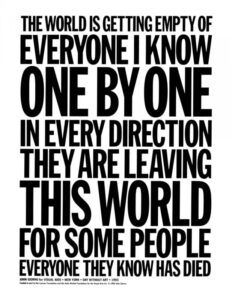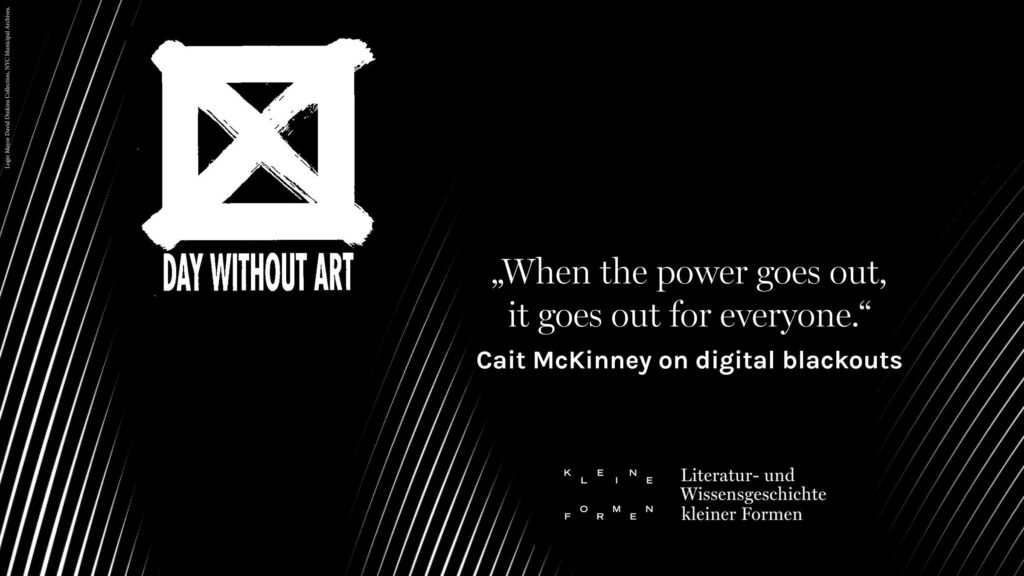A Queer History of Blackouts
In this episode
In the first episode of this three-part series on the circulation of small forms, media scholar Cait McKinney revisits AIDS activism in the 1990s. Focusing on the Day Without Art project, they demonstrate how queer activists adopted the aesthetics of blackouts as an online protest tactic to expose systemic failures during the HIV crisis. Through small-scale interventions such as web banners, activists disrupted digital infrastructures, blocking access to information that was normally readily available. In doing so, they made visible the erasure experienced by particularly vulnerable populations—what was once present became absent, ripped out, and lost. But queer activists not only sabotaged information flows on websites. McKinney shows that this protest tactic was used in other contexts as well, including art galleries, public transport, and governmental buildings. These interventions developed into distinct modes of communication and mediation—interrupting infrastructures so that the HIV crisis could no longer be ignored. In this episode, Cait McKinney frames the blackout as a digital tactic of minoritized groups, situating it within the broader framework of queer media theory.
Cait McKinney is an associate professor of communication at Simon Fraser University in British Columbia, Canada. Their research focuses on queer media studies, media history, queer theory, and activist media. Among other publications, they are the author of Information Activism: A Queer History of Lesbian Media Technologies, in which they examine the often-overlooked information practices of lesbian-feminist activists in the US and Canada during the 1970s and 1980s. Cait McKinney was one of three keynote speakers at the conference Small Forms in Circulation: Infrastructures, Practices, Publics, organized by Gesche Mirjam Beyer, Claas Oberstadt, Marvin Renfordt, Morten Schneider, and Anya Shchetvina.
Recommended citation:
“A Queer History of Blackouts”. Lecture by Cait McKinney, in: microform. Der Podcast des Graduiertenkollegs Literatur- und Wissensgeschichte kleiner Formen, available at: www.kleine-formen.de/queer-history-of-blackouts, Berlin 2025 [Date of last access].
Images:

Day Without Art banner, provided to sites participating in blackout. Image by Visual AIDS and Creative Time, via Internet Archive.

John Giorno “everyone I know,” original print broadside for Visual AIDS (1993), Visual AIDS Archives, https://visualaids.org/projects/john-giorno.

John Giorno’s “everyone I know” animated in segments as browser windows for the 1995 DWA web action by GH Hovagimyan. Image from Carol Stakenas, “Crossing the Threshold: Examining the Public Space of the Web through Day Without Art Web Action,” in Women, Art, Technology, edited by Judy Mallot (Cambridge: MIT Press, 2003).
Audio file:
David Wojnarowicz speaking at MOMA event “In Memoriam: A Gathering of Hope, A Day Without Art,” Nov 30, 1989, MOMA New York.
References:
Berlant, Lauren. „Cruel optimism.“ Duke University Press (2011).
Malatino, Hil. „Future fatigue: Trans intimacies and trans presents (or how to survive the interregnum).“ Transgender Studies Quarterly 6.4 (2019): 635-658.
Sharma, Sarah. „Exit and the Extensions of Man.“ Transmediale online journal (2017).
Credits
Moderation
Gesche Mirjam Beyer, Marvin Renfordt
Editor
Marvin Renfordt
Mastering
Johann Gartlinger
Script
Gesche Mirjam Beyer, Marvin Renfordt
Credits are read by
Johann Gartlinger
Music
“Karl’s Pultz” by Blue Dot Sessions
Jingle
Michael Hoeldke (composition) and Cathrin Bonhoff (voice)


